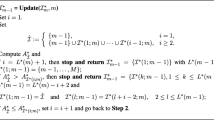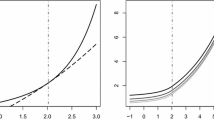Abstract
We study, from the perspective of optimal stopping theory, entry–exit decision problems of a project in the context that the log-price process follows a Lévy process with exponential jumps. A closed-form solution to the problems is obtained. To be specific, we show explicitly an optimal entry time, an optimal exit time and an expression of the maximal expected present value of the project. Moreover, it is also anatomized how the jumping of the Lévy process affects optimal entry and exit times. While the negative effect of jumping on prices grows, the optimal exit time gets earlier, and the optimal entry time, however, first moves up and then moves down. In addition, the optimal exit time decreases with the frequency increasing of jumps when the negative effect dominates the positive effect, and increases when the opposite situation holds; the optimal entry time first increases and then decreases as the frequency becomes higher if the negative effect dominates the positive effect, and increases if the contrary condition is satisfied.







Similar content being viewed by others
References
Dixit, A.: Entry and exit decisions under uncertainty. J. Polit. Econ. 97(3), 620–638 (1989)
Shirakawa, H.: Evaluation of investment opportunity under entry and exit decisions. Math. Anal. Econ. 987, 107–124 (1997)
Boyarchenko, S., Levendorskiǐ, S.: Irreversible Decisions Under Uncertainty: Optimal Stopping Made Easy. Springer, Berlin (2007)
Duckworth, J.K., Zervos, M.: An investment model with entry and exit decisions. J. Appl. Prob. 37(2), 547–559 (2000)
Sødal, S.: Entry and exit decisions based on a discount factor approach. J. Econ. Dyn. Control 30(11), 1963–1986 (2006)
Zhang, Y.: Entry and exit decisions with linear costs under uncertainty. Stoch. Int. J. Probab. Stoch. Process. 87(2), 209–234 (2015)
Tsekrekos, A.E.: The effect of mean reversion on entry and exit decisions under uncertainty. J. Econ. Dyn. Control 34(4), 725–742 (2010)
Levendorskiǐ, S.: Perpetual American options and real options under mean-reverting processes (2005). SSRN: http://ssrn.com/abstract=714321. doi:10.2139/ssrn.714321
Bar-Ilan, A., Strange, W.C.: Investment lags. Am. Econ. Rev. 86(3), 610–622 (1996)
Gauthier, L., Morellec, E.: Investment under uncertainty with implementation delay. In: New Developments and Applications in Real Options. Oxford University Press, Oxford (2000). https://infoscience.epfl.ch/record/188140/files/morellec_delay.PDF
Øksendal, B.: Optimal stopping with delayed information. Stoch. Dyn. 5(2), 271–280 (2005)
Costeniuc, M., Schnetzer, M., Taschini, L.: Entry and exit decision problem with implementation delay. J. Appl. Prob. 45(4), 1039–1059 (2008)
Zhang, Y.C.: Entry–exit decisions with implementation delay under uncertainty (2015). ArXiv preprint arXiv:1503.01285v2
Øksendal, B., Sulem, A.: Applied Stochastic Control of Jump Diffusions, 2nd edn. Springer, Berlin (2007)
Karatzas, I., Shreve, S.E.: Brownian Motion and Stochastic Calculus, 2nd edn. Springer, New York (1991)
Protter, P.E.: Stochastic Integration and Differential Equations, 2nd edn. Springer, Berlin (2005)
Chan, T.: Pricing contingent claims on stocks driven by Lévy processes. Ann. Appl. Probab. 9(2), 504–528 (1999)
Mordecki, E.: Optimal stopping and perpetual options for lévy processes. Finance Stoch. 6(4), 473–493 (2002)
Corcuera, J.M., Guerra, J., Nualart, D., Schoutens, W.: Optimal investment in a lévy market. Appl. Math. Optim. 53(3), 279–309 (2006)
Acknowledgments
Many thanks are due to the editors and reviewers for their constructive suggestions and valuable comments. This work is partially supported by the Fundamental Research Funds for the Central Universities (Grant No. N142303010).
Author information
Authors and Affiliations
Corresponding author
Rights and permissions
About this article
Cite this article
Zhang, YC. Entry–Exit Decisions with Underlying Processes Following Geometric Lévy Processes. J Optim Theory Appl 172, 309–327 (2017). https://doi.org/10.1007/s10957-016-1026-7
Received:
Accepted:
Published:
Issue Date:
DOI: https://doi.org/10.1007/s10957-016-1026-7




